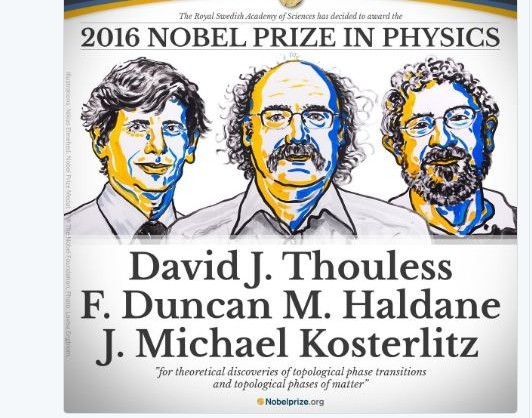David J. Thouless, F. Duncan M. Haldane and J. Michael Kosterlitz were awarded the 2016 Nobel Prize in Physics on Tuesday for discoveries in condensed-matter physics that have transformed the understanding of matter that assumes strange shapes. All three were born in Britain but work in the United States. Using advanced mathematical models, the three scientists studied unusual phases, or states, of matter, such as superconductors, superfluids or thin magnetic films. Their findings have relevance for materials science and electronics. Dr. Thouless of the University of Washington, Dr. Haldane of Princeton University and Dr. Kosterlitz of Brown University were honored by the Royal Swedish Academy of Sciences in Stockholm for “theoretical discoveries of topological phase transitions and topological phases of matter.” Dr. Thouless was awarded half of the prize of 8 million Swedish kronor, or about 930,000 dollars while Dr. Haldane and Dr. Kosterlitz will share the other half. Michael S. Turner, a physicist at the University of Chicago, said that the work of the three prizewinners was “truly transformational, with long-term consequences both practical and fundamental.”“It illustrates the importance and surprises associated with curiosity-driven research,” he added. At a news conference in Stockholm, Thors Hans Hansson, a member of the Nobel physics committee, used a bagel, a pretzel and a cinnamon bun to explain topology. While the items vary across many variables, a topologist focuses only on the holes: The pretzel has two, the bagel has one, and the bun has none. “Things like taste or shape or deformation can change continuously, but the number of holes — something that we call the topological invariant — can only change by integers, like 1, 2, 3, 0,” he said. This topological insight turned out to be useful in understanding the conductance — the ease with which electric current flows through a substance — in certain two-dimensional materials at extremely low temperatures and in strong magnetic fields. While the research was largely theoretical, it could have practical applications for items like electronics, superconductors and even computers.
Nobel physics prize 2016 to be shared by British scientists
The three scientists ‘revealed the secrets of exotic matter’





































